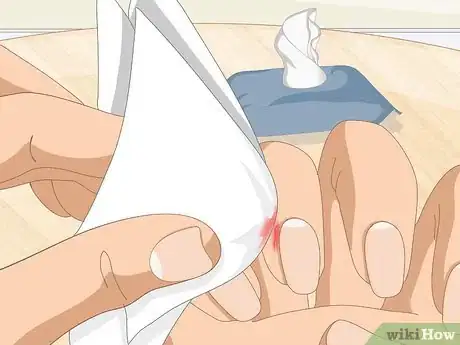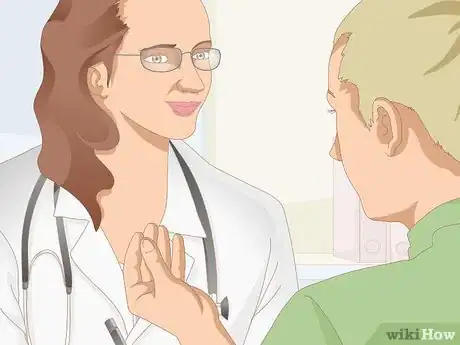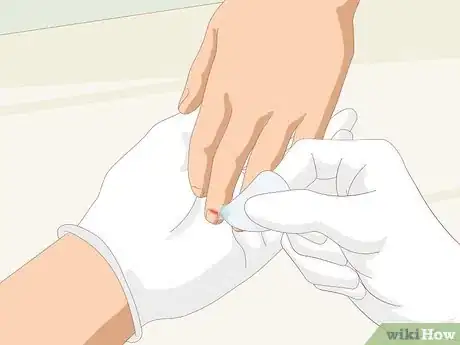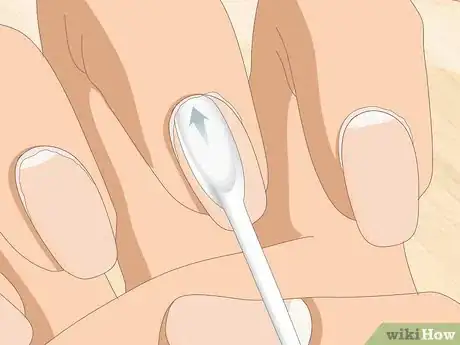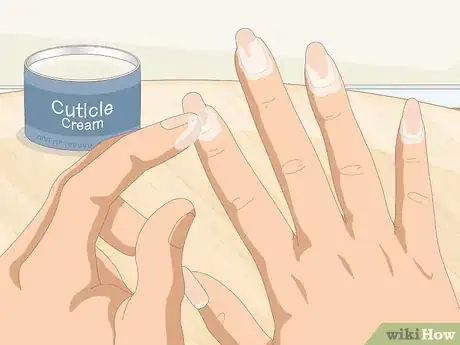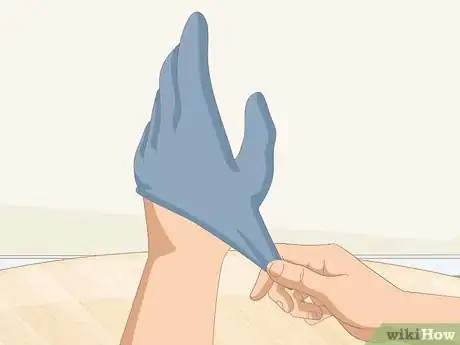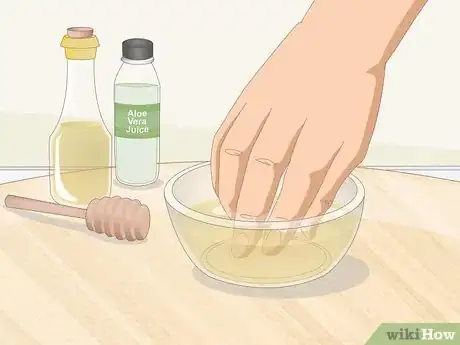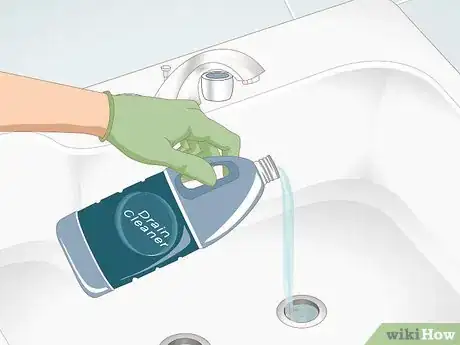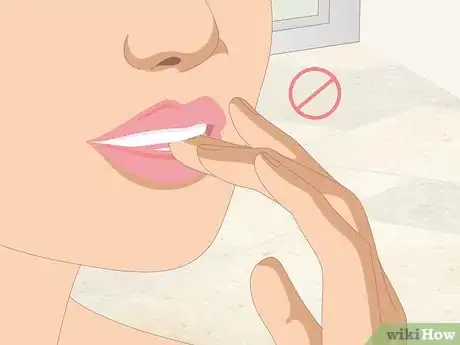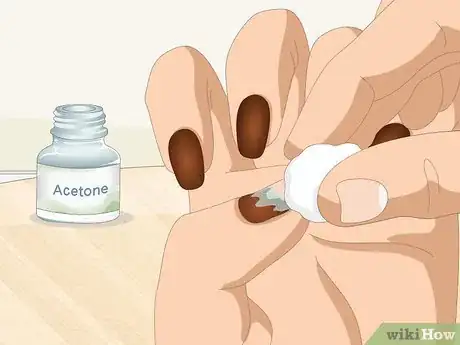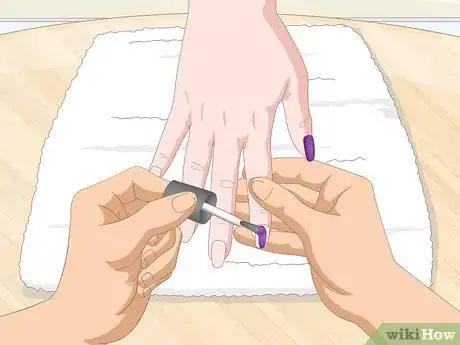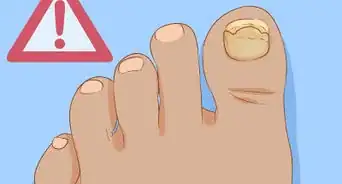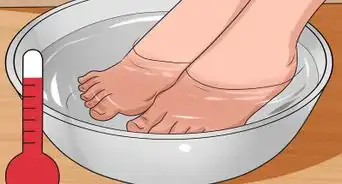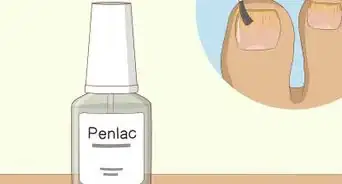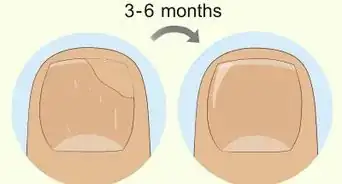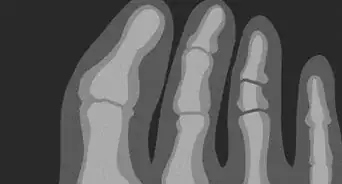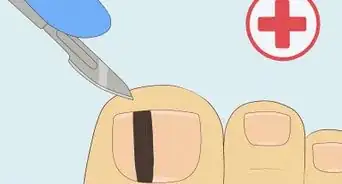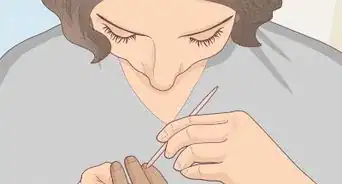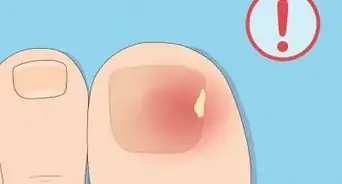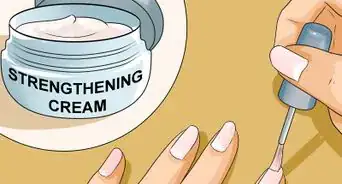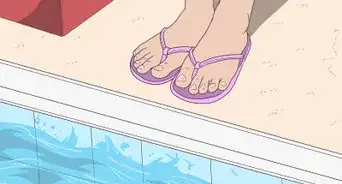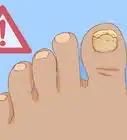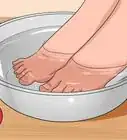This article was co-authored by Mohiba Tareen, MD. Mohiba Tareen is a board certified Dermatologist and the founder of Tareen Dermatology located in Roseville, Maplewood and Faribault, Minnesota. Dr. Tareen completed medical school at the University of Michigan in Ann Arbor, where she was inducted into the prestigious Alpha Omega Alpha honor society. While a dermatology resident at Columbia University in New York City, she won the Conrad Stritzler award of the New York Dermatologic Society and was published in The New England Journal of Medicine. Dr. Tareen then completed a procedural fellowship which focused on dermatologic surgery, laser, and cosmetic dermatology.
There are 13 references cited in this article, which can be found at the bottom of the page.
This article has been viewed 103,772 times.
The skin around your nails, also known as your cuticle, can be easily damaged. To keep your cuticles healthy, start by determining what injured them in the first place. If needed, speak with your doctor to rule out any more serious medical causes. Avoid cutting your cuticles and simply push them back as needed. Apply cuticle oil on a regular basis. Getting a hand massage can also help to increase blood flow to your fingertips, which can speed up the healing process.
Steps
Treating Any Injuries
-
1Determine the cause of injury. Take a close look at the skin surrounding your nail and try to pinpoint what the problem might be, as this will directly impact your course of treatment. Look for signs of picking or biting. Test out the texture of the skin to see if it feels dry or brittle. Look at the color, as a yellowish tint could indicate an infection or fungus.[1]
- Your cuticle should also lay relatively flat against your nail. Extra bumps or ridge can be a sign of trauma or even an illness, such as kidney disease. If you see these, talk to your doctor for guidance and treatment.
- If the nail or cuticle feels brittle, applying cuticle oil and moisturizer on a daily basis should help to hydrate the skin and nail area.[2]
- You should be able to see a half-moon shape at the bottom of your nails. If it is not immediately present, try pressing down lightly on your nails. If you still cannot see it, it may be a sign of other underlying health issues, such as hyperthyroidism. In this case, consult a doctor.[3]
- If you see signs of fungus, then start by applying an anti-fungal cream, as directed. If this doesn't work, talk with your doctor. They may prescribe a pill that can help.
-
2Treat any cuts or open sores. Your hands come into contact with all sorts of germs throughout the day and allowing a cut to go untreated allows these things to enter into your body. Wipe down any cuts with a prepackaged alcohol wipe. Apply a tiny bit of Neosporin and then cover the area with a bandaid. If the cut is small, let it air dry, but keep an eye on it.[4]
- If you go with a Band-Aid, make sure to remove and replace it every few hours, so that your cut can breathe.
Advertisement -
3Talk with a doctor. If all of your cuticles are causing you pain or if you just can’t seem to heal them, then it may be time to make an appointment with your general physician. It is possible that a more serious infection is causing your problems or even a hormonal issue. If the nail structure looks injured, your doctor may call for an x-ray to check for any broken bones.[5]
- Tell your doctor if you have recently slammed or hit your hands against another object or if you work with construction tools. They will check for hand injuries just in case.
- Be aware that long-term damage to the cuticle area can cause deformities to the entire finger. That is why it is good idea to talk with your doctor if you suspect something more serious or if you damaged your cuticle via an injury.
- If you bite your nails until they bleed or if you feel as if you can’t stop picking or biting your cuticles, then you should speak with a mental health professional to help end these behaviors.[6]
-
4Seek emergency assistance. If you’ve damaged your nail bed and cuticle by crushing or if you’ve received a deep cut to this area, then it is a good idea to seek medical assistance as soon as possible. Leaving a serious injury untended can cause damage to the nerve endings, among other complications.
- A nail avulsion, or when a portion of the nail is pulled away from the cuticle and underlying skin, is also an injury requiring quick treatment. Avulsions are often accompanied by distal tuft fractures of the finger after blunt trauma.[7]
- In some cases, the entire nail bed may be removed to ensure proper healing. Try not to worry. The nail will grow back in around six months.
Building Stronger Cuticles
-
1Push the cuticle back without cutting. Instead of sniping or trimming your cuticles, try to push them back gently with a nail pusher, sold in the beauty sections of most stores. Try shaping your cuticles directly after getting out of the shower when they are pliable. It is important to keep the cuticle intact when possible, as it your finger’s natural barrier against germs.[8]
- It is okay to clip any hangnails or large pieces of excess skin with a sanitized pair of small scissors. Just be careful to not nick the healthy skin and avoiding clipping when possible.[9]
-
2Apply a cuticle cream or serum.[10] After you’ve pushed back the cuticle, apply a liberal dose of cuticle cream to the nail and surrounding skin. Many people prefer to incorporate this as part of a post-shower ritual. If your cuticles are particularly damaged, you might want to apply a healing cream multiple times each day, especially after washing your hands.
- If you want to spend a bit more, look for a specialty product, such as rose hip oil, which contains additional vitamin A to promote healing.[11]
-
3Go without nail polish. The chemicals in nail polish can irritate your cuticles and nails. Try to let your nails go bare for a few weeks if you notice that your cuticles are irritated or damaged.[12] When you decide to go back to polish, talk to your manicurist about choosing a type that is good for sensitive nails and cuticles.[13]
-
4Wear moisturizing socks or gloves. Add moisturizer to your nails at night before going to bed. Put on a pair of cotton gloves or socks afterwards. This will keep the moisture close to your skin and will also keep you from getting everything else oily that you touch. Covering your hands or feet protects them from dry air as well, which can cause cracking.[14]
- If you bite your nails, wearing gloves or socks can help prevent you from biting in your sleep. This is also effective with children who bite their nails.
- Don’t be afraid to go a bit heavy on the moisturizer, as some of it will wipe off on the gloves or socks.[15]
-
5Soak them. Get a bowl and mix together aloe vera juice, olive oil, and raw honey. Place your fingers in the bowl and coat your hands with this mixture. Keep them soaking for five minutes or so. Repeat three times a week for the best results.[16]
- Get a bit creative with the soaking ingredients, if you like. Place your fingers in orange juice, milk, or even coconut oil for healing.[17]
- You can purchase a paraffin wax bath at most pharmacies. For this treatment, you will heat up the wax, and soak your hands until the wax hardens again. Peel off the wax when you are done for softer, smoother skin and nails.
Protecting Your Cuticles
-
1Limit your exposure to harmful substances. Wear gloves when working with cleaners and other chemicals. Avoid keeping your nails in the sun for an extended period of time without cover or a coating of moisturizer. Using sensitive soap when washing your hands to prevent drying them out.[18]
-
2Stop biting or picking your nails. Many people tear into their nails and cuticles without even realizing it. Make a point of stopping these behaviors. It may be helpful to coat your nails with a bitter substance, such as lemon oil. Reward yourself with a nice manicure once your cuticles are fully healed.[19]
- You can purchase a bitter solution or nail polish to put on your nails. This will make your nails taste bad, encouraging you to stop biting them.
-
3Be careful when removing polish or nails. Acetone is the easiest way to remove polish and artificial nails, but it is also really harsh on your surrounding skin. Taking a break from polish and manicures will give your nails time to heal.[20] But, before you take that break, go slowly when removing the polish and choose a gentle, 10-free removing solution.[21]
-
4Get a hand massage. Increasing the blood flow to your hands and fingers will also help your cuticles to heal and continue to grow. Either give yourself a hand massage with a hot towel while soaking your fingers or go to a professional masseuse.[22]
-
5See a manicurist. When your cuticles are healthy again, treat yourself to a professional manicure. Getting your nails done actually encourages healthy growth and helps to repair damage. Make your technician aware of any concerns that you have regarding your cuticles. Request that they push the cuticles back without cutting.[23]
-
6Be patient. It is very frustrating to live with painful or damaged cuticles. But, they will likely take between 3-6 months to fully heal. Be gentle with your hands during this time and try not to rush into a new polish or potentially damaging nail application.
Expert Q&A
Did you know you can get expert answers for this article?
Unlock expert answers by supporting wikiHow
-
QuestionWhy are my cuticles so damaged?
 Mohiba Tareen, MDMohiba Tareen is a board certified Dermatologist and the founder of Tareen Dermatology located in Roseville, Maplewood and Faribault, Minnesota. Dr. Tareen completed medical school at the University of Michigan in Ann Arbor, where she was inducted into the prestigious Alpha Omega Alpha honor society. While a dermatology resident at Columbia University in New York City, she won the Conrad Stritzler award of the New York Dermatologic Society and was published in The New England Journal of Medicine. Dr. Tareen then completed a procedural fellowship which focused on dermatologic surgery, laser, and cosmetic dermatology.
Mohiba Tareen, MDMohiba Tareen is a board certified Dermatologist and the founder of Tareen Dermatology located in Roseville, Maplewood and Faribault, Minnesota. Dr. Tareen completed medical school at the University of Michigan in Ann Arbor, where she was inducted into the prestigious Alpha Omega Alpha honor society. While a dermatology resident at Columbia University in New York City, she won the Conrad Stritzler award of the New York Dermatologic Society and was published in The New England Journal of Medicine. Dr. Tareen then completed a procedural fellowship which focused on dermatologic surgery, laser, and cosmetic dermatology.
FAAD Board Certified Dermatologist The nails are a reflection of your skin. The nail should be moisturized just like the rest of your body should be moisturized. Whenever you moisturize your hands, be sure to also moisturize around your cuticle. You can also minimize nail polish and nail polish removal, as both can dry out your nails over time.
The nails are a reflection of your skin. The nail should be moisturized just like the rest of your body should be moisturized. Whenever you moisturize your hands, be sure to also moisturize around your cuticle. You can also minimize nail polish and nail polish removal, as both can dry out your nails over time.
Warnings
- Make sure that the salons that you visit for manicures and pedicures follow proper sanitation and sterilization practices.[24]⧼thumbs_response⧽
References
- ↑ http://www.nytimes.com/health/guides/symptoms/nail-abnormalities/overview.html
- ↑ Mohiba Tareen, MD. FAAD Board Certified Dermatologist. Expert Interview. 26 March 2020.
- ↑ http://www.aafp.org/afp/2004/0315/p1417.html
- ↑ http://www.teenvogue.com/story/how-to-fix-broken-nail-hangnail-cuticle
- ↑ http://www.oprah.com/style/how-to-cure-dry-splitting-nails-and-cuticles#ixzz4gcfAL2KJ
- ↑ http://www.nytimes.com/health/guides/symptoms/nail-abnormalities/overview.html
- ↑ http://www.emedicinehealth.com/nail_injuries/page2_em.htm
- ↑ http://www.teenvogue.com/story/how-to-fix-broken-nail-hangnail-cuticle
- ↑ http://www.prevention.com/beauty/prevent-hangnails
- ↑ Mohiba Tareen, MD. FAAD Board Certified Dermatologist. Expert Interview. 26 March 2020.
- ↑ https://www.newbeauty.com/blog/dailybeauty/10697-how-to-stop-your-cuticles-from-cracking-and-peeling/
- ↑ Mohiba Tareen, MD. FAAD Board Certified Dermatologist. Expert Interview. 26 March 2020.
- ↑ http://www.huffingtonpost.com/2015/04/21/do-nails-breathe_n_7087158.html
- ↑ http://www.prevention.com/beauty/prevent-hangnails
- ↑ http://www.health.com/beauty/3-ways-to-repair-your-nails-after-a-gel-manicure
- ↑ http://www.huffingtonpost.com/2014/10/22/homemade-cures-dry-skin-rough-heels_n_4136308.html
- ↑ http://www.instyle.com/how-tos/how-to-get-healthy-nails-after-acrylics
- ↑ http://www.huffingtonpost.com/2015/04/21/do-nails-breathe_n_7087158.html
- ↑ http://www.nytimes.com/health/guides/symptoms/nail-abnormalities/overview.html
- ↑ Mohiba Tareen, MD. FAAD Board Certified Dermatologist. Expert Interview. 26 March 2020.
- ↑ https://www.newbeauty.com/blog/dailybeauty/10697-how-to-stop-your-cuticles-from-cracking-and-peeling/
- ↑ http://www.instyle.com/how-tos/how-to-get-healthy-nails-after-acrylics
- ↑ http://www.instyle.com/how-tos/how-to-get-healthy-nails-after-acrylics
- ↑ http://stylecaster.com/beauty/cuticles/#ixzz4gchVbKH6
About This Article
Cuticles can be easily damaged, but if you treat any injuries and keep them moisturized, they’ll heal pretty easily. If you have any cuts or sores on your cuticles, wipe them down with an alcohol wipe to clean them. Then, apply some antibiotic ointment and a bandaid to keep them protected. If your cuticles are just dry, apply cuticle cream or serum to help them heal. If you don’t have cuticle cream, try soaking your nails in a mix of aloe vera juice, olive oil, and raw honey for 5 minutes or so. You can do this soak 3 times a week to keep your cuticles soft and moisturized. You can also apply lotion to your hands before bed and sleep with cotton gloves on, which will help prevent your cuticles from cracking. To learn how to protect your cuticles when painting your nails, read on!


